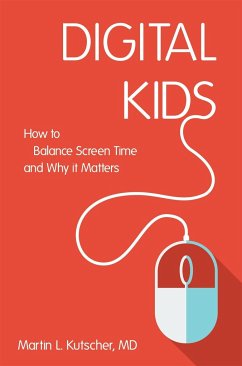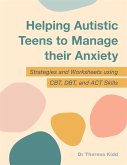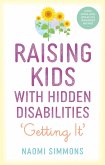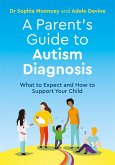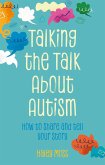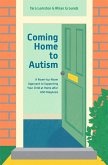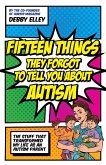16,99 €
inkl. MwSt.
Versandfertig in über 4 Wochen

8 °P sammeln
- Broschiertes Buch
- Merkliste
- Auf die Merkliste
- Bewerten Bewerten
- Teilen
- Produkt teilen
- Produkterinnerung
- Produkterinnerung
Help children and young people to have healthy relationships with the internet with this handy book. Showing you when and why exposure to digital media becomes excessive and problematic, this book also provides practical steps for dealing with problems effectively. The book also includes advice for working with kids with ADHD and autism.
Andere Kunden interessierten sich auch für
![Helping Autistic Teens to Manage Their Anxiety Helping Autistic Teens to Manage Their Anxiety]() Dr Theresa KiddHelping Autistic Teens to Manage Their Anxiety36,99 €
Dr Theresa KiddHelping Autistic Teens to Manage Their Anxiety36,99 €![Raising Kids with Hidden Disabilities Raising Kids with Hidden Disabilities]() Naomi SimmonsRaising Kids with Hidden Disabilities29,99 €
Naomi SimmonsRaising Kids with Hidden Disabilities29,99 €![A Parent's Guide to Autism Diagnosis A Parent's Guide to Autism Diagnosis]() Adele DevineA Parent's Guide to Autism Diagnosis28,99 €
Adele DevineA Parent's Guide to Autism Diagnosis28,99 €![Talking the Talk about Autism Talking the Talk about Autism]() Haley MossTalking the Talk about Autism16,99 €
Haley MossTalking the Talk about Autism16,99 €![Coming Home to Autism Coming Home to Autism]() Tara LenistonComing Home to Autism28,99 €
Tara LenistonComing Home to Autism28,99 €![Fifteen Things They Forgot to Tell You about Autism Fifteen Things They Forgot to Tell You about Autism]() Debby ElleyFifteen Things They Forgot to Tell You about Autism19,99 €
Debby ElleyFifteen Things They Forgot to Tell You about Autism19,99 €![Understanding and Evaluating Autism Theory Understanding and Evaluating Autism Theory]() Nick ChownUnderstanding and Evaluating Autism Theory45,99 €
Nick ChownUnderstanding and Evaluating Autism Theory45,99 €-
-
-
Help children and young people to have healthy relationships with the internet with this handy book. Showing you when and why exposure to digital media becomes excessive and problematic, this book also provides practical steps for dealing with problems effectively. The book also includes advice for working with kids with ADHD and autism.
Hinweis: Dieser Artikel kann nur an eine deutsche Lieferadresse ausgeliefert werden.
Hinweis: Dieser Artikel kann nur an eine deutsche Lieferadresse ausgeliefert werden.
Produktdetails
- Produktdetails
- Verlag: Jessica Kingsley Publishers
- Seitenzahl: 144
- Erscheinungstermin: 21. Oktober 2016
- Englisch
- Abmessung: 216mm x 139mm x 15mm
- Gewicht: 172g
- ISBN-13: 9781785927126
- ISBN-10: 1785927124
- Artikelnr.: 44976994
- Herstellerkennzeichnung
- Libri GmbH
- Europaallee 1
- 36244 Bad Hersfeld
- gpsr@libri.de
- Verlag: Jessica Kingsley Publishers
- Seitenzahl: 144
- Erscheinungstermin: 21. Oktober 2016
- Englisch
- Abmessung: 216mm x 139mm x 15mm
- Gewicht: 172g
- ISBN-13: 9781785927126
- ISBN-10: 1785927124
- Artikelnr.: 44976994
- Herstellerkennzeichnung
- Libri GmbH
- Europaallee 1
- 36244 Bad Hersfeld
- gpsr@libri.de
Martin L. Kutscher, MD
1. Introduction. Part One: Problems with the Use of Digital Technology. 2.
Psychological/learning effects of Internet use. 3. How does our attention
system work? 4. "But mom, I can pay attention to more than one thing at a
time!" The myth of "multi-tasking". 5. Screens interfere with developing
voluntary attention. 6. Areas where digital learning does excel. 7. Summary
of digital vs. print effects on learning. 8. Other psychological effects of
the Internet. 9. Neurological effects of Internet abuse. 10. Physical
effects of digital media use. Part Two: Problems with the Content of the
Digital Technology. 11. Social Media. 12. Does pornography and other media
exposure affect sexuality. 13. Does media exposure increase the risk of
violent behavior? 14. Do violent videogames lead to violent behavior? 15.
Does media effect substance use? 16. Resultant AAP (2013) recommendations
regarding digital media. Part Three: Problems Regarding Specific
Populations. 17. Very young children and screen time. 18. Children with
ADHD and screen time. 19. Children with Autism Spectrum Disorder (ASD) and
screen time. Part Four: The Parental Role. 20. What kind of role model am I
for my child? 21. How do I set limits for my child? Part Five: Setting Up
the Rules: The Family Meeting and Agreement. 22. The family meeting. 23.
The agreement. Part Six: Internet Addiction: The Far End of Internet
Problems. 24. Internet problems cover a whole range of severity. 25. What
is an addiction? 26. How does someone get addicted? 27. How common is
Internet addiction? 28. Why is digital media so addicting? 29. What are
particularly addicting Internet activities? 30. What personal traits are
associated with Internet addiction? 31. How do we treat Internet addiction?
Part Seven: Summary. 32. The recent explosion of digital technology and
services. 33. The extent of screen time usage. 34. The parents' dilemma and
role in setting limits. 35. Problems with the use of the Internet. 36.
Problems with the content of the Internet. 37. Problems regarding specific
populations. 38. The parental role. 39. Setting up the rules: the family
meeting and agreement. 40. Internet addiction: The far end of Internet
problems. References. Resources. About the authors.
Psychological/learning effects of Internet use. 3. How does our attention
system work? 4. "But mom, I can pay attention to more than one thing at a
time!" The myth of "multi-tasking". 5. Screens interfere with developing
voluntary attention. 6. Areas where digital learning does excel. 7. Summary
of digital vs. print effects on learning. 8. Other psychological effects of
the Internet. 9. Neurological effects of Internet abuse. 10. Physical
effects of digital media use. Part Two: Problems with the Content of the
Digital Technology. 11. Social Media. 12. Does pornography and other media
exposure affect sexuality. 13. Does media exposure increase the risk of
violent behavior? 14. Do violent videogames lead to violent behavior? 15.
Does media effect substance use? 16. Resultant AAP (2013) recommendations
regarding digital media. Part Three: Problems Regarding Specific
Populations. 17. Very young children and screen time. 18. Children with
ADHD and screen time. 19. Children with Autism Spectrum Disorder (ASD) and
screen time. Part Four: The Parental Role. 20. What kind of role model am I
for my child? 21. How do I set limits for my child? Part Five: Setting Up
the Rules: The Family Meeting and Agreement. 22. The family meeting. 23.
The agreement. Part Six: Internet Addiction: The Far End of Internet
Problems. 24. Internet problems cover a whole range of severity. 25. What
is an addiction? 26. How does someone get addicted? 27. How common is
Internet addiction? 28. Why is digital media so addicting? 29. What are
particularly addicting Internet activities? 30. What personal traits are
associated with Internet addiction? 31. How do we treat Internet addiction?
Part Seven: Summary. 32. The recent explosion of digital technology and
services. 33. The extent of screen time usage. 34. The parents' dilemma and
role in setting limits. 35. Problems with the use of the Internet. 36.
Problems with the content of the Internet. 37. Problems regarding specific
populations. 38. The parental role. 39. Setting up the rules: the family
meeting and agreement. 40. Internet addiction: The far end of Internet
problems. References. Resources. About the authors.
1. Introduction. Part One: Problems with the Use of Digital Technology. 2.
Psychological/learning effects of Internet use. 3. How does our attention
system work? 4. "But mom, I can pay attention to more than one thing at a
time!" The myth of "multi-tasking". 5. Screens interfere with developing
voluntary attention. 6. Areas where digital learning does excel. 7. Summary
of digital vs. print effects on learning. 8. Other psychological effects of
the Internet. 9. Neurological effects of Internet abuse. 10. Physical
effects of digital media use. Part Two: Problems with the Content of the
Digital Technology. 11. Social Media. 12. Does pornography and other media
exposure affect sexuality. 13. Does media exposure increase the risk of
violent behavior? 14. Do violent videogames lead to violent behavior? 15.
Does media effect substance use? 16. Resultant AAP (2013) recommendations
regarding digital media. Part Three: Problems Regarding Specific
Populations. 17. Very young children and screen time. 18. Children with
ADHD and screen time. 19. Children with Autism Spectrum Disorder (ASD) and
screen time. Part Four: The Parental Role. 20. What kind of role model am I
for my child? 21. How do I set limits for my child? Part Five: Setting Up
the Rules: The Family Meeting and Agreement. 22. The family meeting. 23.
The agreement. Part Six: Internet Addiction: The Far End of Internet
Problems. 24. Internet problems cover a whole range of severity. 25. What
is an addiction? 26. How does someone get addicted? 27. How common is
Internet addiction? 28. Why is digital media so addicting? 29. What are
particularly addicting Internet activities? 30. What personal traits are
associated with Internet addiction? 31. How do we treat Internet addiction?
Part Seven: Summary. 32. The recent explosion of digital technology and
services. 33. The extent of screen time usage. 34. The parents' dilemma and
role in setting limits. 35. Problems with the use of the Internet. 36.
Problems with the content of the Internet. 37. Problems regarding specific
populations. 38. The parental role. 39. Setting up the rules: the family
meeting and agreement. 40. Internet addiction: The far end of Internet
problems. References. Resources. About the authors.
Psychological/learning effects of Internet use. 3. How does our attention
system work? 4. "But mom, I can pay attention to more than one thing at a
time!" The myth of "multi-tasking". 5. Screens interfere with developing
voluntary attention. 6. Areas where digital learning does excel. 7. Summary
of digital vs. print effects on learning. 8. Other psychological effects of
the Internet. 9. Neurological effects of Internet abuse. 10. Physical
effects of digital media use. Part Two: Problems with the Content of the
Digital Technology. 11. Social Media. 12. Does pornography and other media
exposure affect sexuality. 13. Does media exposure increase the risk of
violent behavior? 14. Do violent videogames lead to violent behavior? 15.
Does media effect substance use? 16. Resultant AAP (2013) recommendations
regarding digital media. Part Three: Problems Regarding Specific
Populations. 17. Very young children and screen time. 18. Children with
ADHD and screen time. 19. Children with Autism Spectrum Disorder (ASD) and
screen time. Part Four: The Parental Role. 20. What kind of role model am I
for my child? 21. How do I set limits for my child? Part Five: Setting Up
the Rules: The Family Meeting and Agreement. 22. The family meeting. 23.
The agreement. Part Six: Internet Addiction: The Far End of Internet
Problems. 24. Internet problems cover a whole range of severity. 25. What
is an addiction? 26. How does someone get addicted? 27. How common is
Internet addiction? 28. Why is digital media so addicting? 29. What are
particularly addicting Internet activities? 30. What personal traits are
associated with Internet addiction? 31. How do we treat Internet addiction?
Part Seven: Summary. 32. The recent explosion of digital technology and
services. 33. The extent of screen time usage. 34. The parents' dilemma and
role in setting limits. 35. Problems with the use of the Internet. 36.
Problems with the content of the Internet. 37. Problems regarding specific
populations. 38. The parental role. 39. Setting up the rules: the family
meeting and agreement. 40. Internet addiction: The far end of Internet
problems. References. Resources. About the authors.
